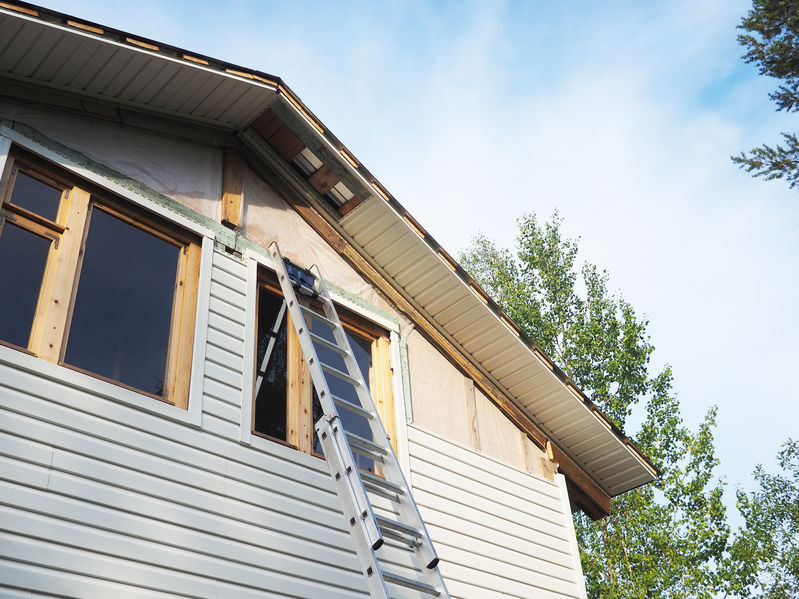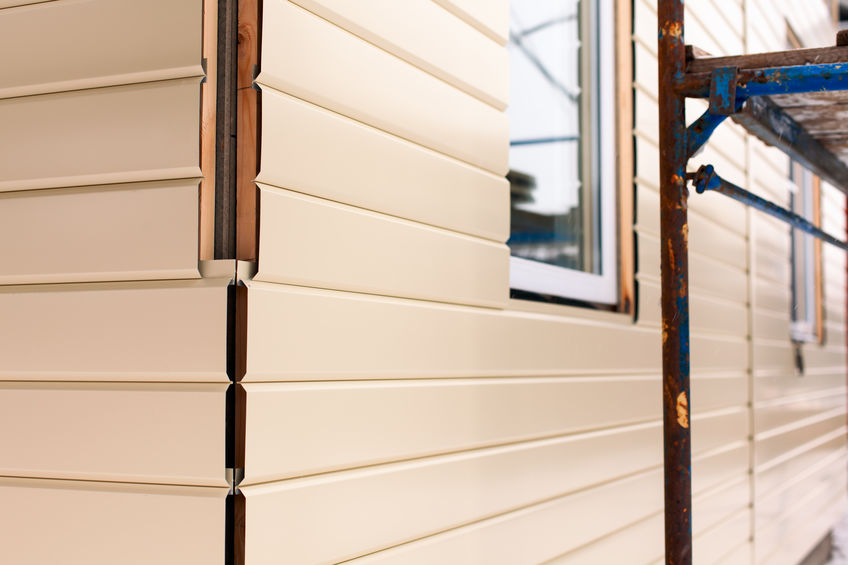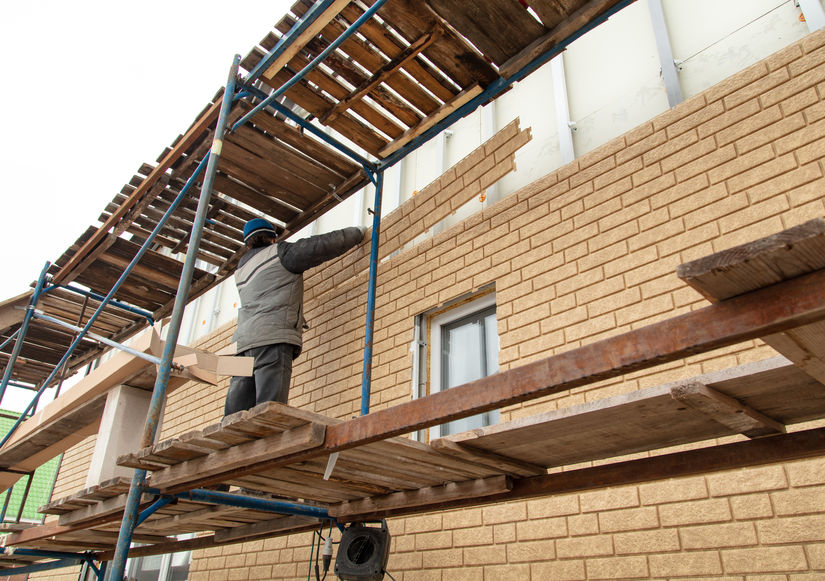So which type of siding should homeowners use? This is obviously one of the first and most important questions to ask, but most of us cannot even name the different kinds of siding until it comes time to invest hard-earned cash and make a choice. Here’s a breakdown of the most popular types of siding, along with their respective advantages and disadvantages.

- Wood
There’s no arguing with natural wood as a classic siding option. It looks beautiful, is completely natural, and often becomes more appealing as it ages. Due to these reasons, wood siding is quite common among homeowners. It is commonly used for bungalows and cottage exteriors. However, to enjoy these benefits, you have to choose the right wood. There are many types of wood to choose from, but some may not be suitable for your local climate.
Wood siding comes as clapboard, shakes, or shingles. Clapboard is made of wood planks installed horizontally with the upper piece overlapping the lower one. Woods like redwood and western red cedar are known for being durable and attractive, hence the best choices for anyone looking for wood siding. Shingles have a uniform appearance but come as thinner than shakes. Due to this, shingles give you a smooth and consistent appearance. You can even cut them into many shapes to give your home’s exterior better visuals. Some manufacturers treat shingles with fire-retardant chemicals, which is a requirement in high-risk areas. Therefore, make sure that you confirm with the local authorities.
Apart from shakes and shingles, engineered wood is another form of wood that can be used for siding. Also referred to as composite wood, engineered wood is made from wooden products and other materials. Veneered plywood, hardboard, and oriented strand board are some examples of engineered wood products that you should consider. Engineered wood is manufactured in form of panels, which are quite easy to install. This means that this siding material is also quite inexpensive to install since it is not labor-intensive. The panels can be molded and made to look like traditional clapboards. Engineered wood has a uniform textured grain, which makes it not look exactly like real wood. However, it still gives a natural appearance to other siding materials like aluminum and vinyl.
Despite these advantages, maintenance requirements for natural wood siding are among the highest, and usually include washing, staining, sealing the wood siding periodically. Therefore, if you love the amazing look that wood siding offers, then you have to do periodic maintenance. Another downside is that wood is susceptible to rodent and insect attacks.

- Brick
Brick is another timeless choice for siding, both because it looks fantastic and lasts a very long time. It is made from clay and the market has genuine bricks to offer, which come in many textures and sizes. Brick is quite common in English, Colonial, and Tudor regions, offering that fantastic look that has managed to stand the test of time. Nowadays, brick siding is normally just a veneer built outside of a home’s wooden frame structure with the bricks held together by mortar.
Brick siding is loved because the maintenance requirements are very low. Washing it every now and then is usually enough. There’s a good reason why so many homes throughout history have featured brick exteriors.
However, even though brick masonry has many functional advantages, the look is simply not for everyone. Water can also penetrate the bricks, especially if you do not have a membrane installed between the brick and the house. Installing brick is also a labor-intensive and time-consuming project. This means that you will pay more to install brick siding than you would when installing another type of siding.
- Vinyl
Made from polyvinyl chloride (plastic) vinyl is definitely among the cheapest options for residential siding. It is important to keep in mind, however, that vinyl siding has made considerable strides in recent years while remaining very low cost. Homeowners are now able to achieve a wide range of designs and appearances using this versatile siding. It also stands up to the elements very well and has almost no maintenance requirements. Vinyl siding is also quite easy to install and you can do the task as a DIY project, as long as you have the right tools needed for the job.
Severe weather can, however, damage vinyl siding. If this happens, professional repair may be necessary. Another issue is that unlike cedar or wood, vinyl does not rot but it can melt. It can also crack, fade, and give off an old and dingy look after some time. Vinyl is also a controversial material due to environmental concerns during its manufacturing. However, some of these problems can be solved by hiring a professional painter to spray on a liquid PVC coating on the siding. This paint is made from resins and polymers and adds an extra layer to the siding, protecting it from the elements.
- Aluminum Siding
Aluminum siding has many benefits, making it quite a common material in the home improvement space. This siding offers a wide array of colors and designs to choose from. It is also quite durable compared to other siding materials in the industry. This feature makes aluminum relatively low maintenance as opposed to other siding materials like wood. Aluminum is offered as a great alternative to other siding materials like vinyl since it offers the same insulation properties. Also, it does not crack or dent but vinyl can. Another advantage it has over vinyl is that it is not considered very harmful. Although another material like vinyl can be recycled, its manufacturing process is known to be quite harsh to the environment.
Despite this, aluminum comes painted and in case the painting is scratched, it will expose a sore spot on your home. An aluminum siding is also susceptible to dents and damage from harsh weather conditions like hail. Something as simple as a stray baseball can cause damage to your siding. Due to these reasons, installing aluminum siding in busy areas or regions with harsh weather conditions might not be a very wise decision.
- Fiber Cement
This is another contemporary synthetic siding option, usually consisting of a mix of cement, sand, and wood fibers. The presence of wood fibers in the mix adds to its strength, and there is a specific technique to “cure” fiber cement and remove all moisture. The result is extremely easy to maintain, strong, and aesthetically pleasing. Fiber cement siding is also non-flammable, termite resistant, and available in a wide array of textures, colors, and styles. The sheer variety of fiber cement allows homeowners to mimic natural stone, brick-and-mortar, or even wood.
Despite this, fiber cement requires periodic painting and a relatively high average cost of installation. This siding material could also encounter moisture-related issues. Another thing is that old houses, built before the late 1980s could have fiber cement siding that contains asbestos, and thus requiring immediate removal.
- Stucco
It is a common assumption that stucco can only be used for a very specific type of house. Spanish or Tudor style properties often make use of this distinct and great-looking type of siding. The material itself—a combination of cement, Silica, and lime—is applied in multiple layers over a frame of metal or wood. It allows the home to remain cool during the summer and warm during the winter, lasts a long time, and is resistant to both fire and sound. However, it is not ideal for areas with excessive rainfall or extreme temperatures. Another issue is that stucco is quite rigid, which makes it a bit hard to install. This makes it quite labor-intensive to install stucco siding and a little more expensive.
- Seamless Steel

Seamless steel is quite sturdy, a feature that makes it able to resist shrinking and bulging, which may be caused by intense temperature changes. You can get seamless steel custom-made to fit the exact measures of your home. You can even purchase a seamless steel siding with a wood-look texture to achieve that natural look of wood.
You may also consider installing corrugated steel, which is quite common for prefabricated military facilities and factories. Therefore, corrugated steel can be considered as more of an industrial material rather than a residential siding material. The good thing about this material is that it can handle harsh weather conditions quite well.
The only major downside with steel is that it is quite labor-intensive, which may translate to higher labor costs and thus an expensive project.
- Stone Veneer
Cement, pigments, and lightweight fragments of rock and mineral constitute this popular and affordable siding option. The Stone veneer gives you the look and feel of a natural stone exterior. However, compared to natural stone, the cost is much lower. It also weighs less than natural stone, making it easier to transport and install. However, since it is essentially a lightweight synthetic product, it lacks the natural durability of real stone.
Which is the Best Siding Material?
Based on the information given in this article, we can comfortably say that wood is probably the best siding material out there. The reasoning behind this is that it gives homeowners many options to choose from in terms of the design, color, and style they want. This means that wood can provide you with a siding that perfectly fits your personality and preferences. Wood can come as shakes, clapboards, or shingles, all of which offer different benefits and are ideal for distinct needs. Apart from that, wood can also be engineered, a feature that makes it quite easy to install. Anyone looking for a natural look on their siding can definitely consider wood. The only issue with wood is that it can be quite hard to maintain. However, sealing and regular cleaning and staining should do the job of ensuring that your wood siding lasts for as long as possible.
Which is the Worst Siding Material?
A siding is meant to protect the house from external elements and give a good curb appeal. Therefore, a bad siding is one that is not able to offer these benefits to a homeowner. Based on the information given in this article, aluminum can be considered as a siding material that is not very good to install in your home. This is because aluminum can be easily scratched, revealing spots, which are not appealing to look at. It is also susceptible to dents and damage from harsh weather conditions like hail.
Another material that is also not good for siding is vinyl. It can be easily damaged by severe weather conditions. It can also crack, melt, fade, and give a dingy look after some time of usage. The way vinyl is manufactured is quite controversial in terms of the environment. In fact, some studies show that vinyl is not environmentally friendly. Although vinyl can be recycled, its manufacturing process is considered very harsh to the environment.
Since the mentioned materials have their own pros and cons, you want to ensure that you make the decision carefully and wisely. This is because aesthetics may be quite appealing but durability is the feature that should matter most. You want a good-looking material that is also versatile, water-resistant, and easy to install. If you are still unsure of the best material for your siding, you might want to reach out to experts for advice on the same.
